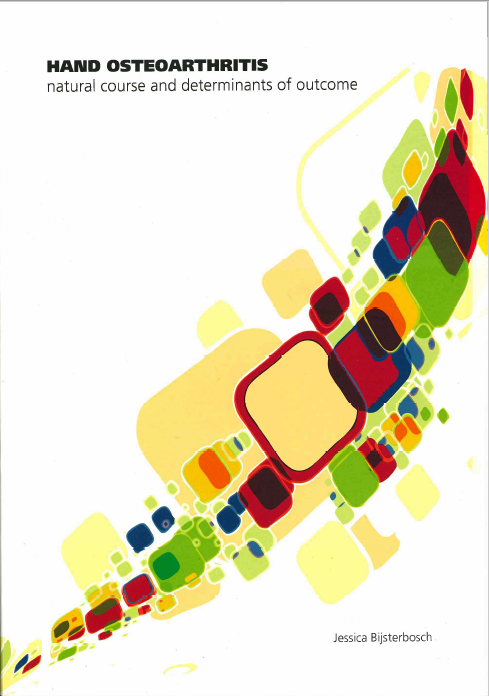GARP Genetics, Arthrosis and Progression
The GARP study is a prospective observational study in patients with familial generalized osteoarthritis or hand osteoarthritis at middle age. All patients have symptoms and definite radiological signs of osteoarthritis and represent an advanced disease state.
The GARP study consists of 3 parts, the baseline study in which 200 sib pairs participate (200-2003) and the progression study in which 100 sib pairs are followed for 2 year (2002-2005). Between 2007 and 2008 all patients will be evaluated again after an average of 5 years. Osteoarthritis and its progression is studied by questionnaires, physical examination, radiographs and MRI. DNA, RNA, serum and urine is collected, to enable the study of genetic risk factors in collaboration with Dr. Ingrid Meulenbelt and Prof. Dr Eline (P.E.) Slagboom and their team, Department of Molecular Epidemiology. In the GARP progression study a knee MRI sub study is performed to investigate underlying pathophysiological mechanisms of osteoarthritis progression and symptoms; this is done in collaboration with Prof. dr J.L. Bloem, dr. Reijnierse and their team, Department of Radiology.
…The GARP study is a prospective observational study in patients with familial generalized osteoarthritis or hand osteoarthritis at middle age. All patients have symptoms and definite radiological signs of osteoarthritis and represent an advanced disease state.
The GARP study consists of 3 parts, the baseline study in which 200 sib pairs participate (200-2003) and the progression study in which 100 sib pairs are followed for 2 year (2002-2005). Between 2007 and 2008 all patients will be evaluated again after an average of 5 years. Osteoarthritis and its progression is studied by questionnaires, physical examination, radiographs and MRI. DNA, RNA, serum and urine is collected, to enable the study of genetic risk factors in collaboration with Dr. Ingrid Meulenbelt and Prof. Dr Eline (P.E.) Slagboom and their team, Department of Molecular Epidemiology. In the GARP progression study a knee MRI sub study is performed to investigate underlying pathophysiological mechanisms of osteoarthritis progression and symptoms; this is done in collaboration with Prof. dr J.L. Bloem, dr. Reijnierse and their team, Department of Radiology.
Within the GARP study the phenotype hand osteoarthritis is broadly studied.
Natural course and determinants of outcome
J. Bijsterbosch, thesis defence date January 8 2013
Hand Osteoarthritis: Natural course and determinants of outcome this follow-up research in the GARP study participants have been invited for a study visit after an average of 6 years to investigate risk factors for progression of osteoarthritis. In this thesis special focus is on hand osteoartritis.
Several phenotypes of hand osteoarthritis exist: nodal hand osteoarthritis, thumb base osteoarthritis and erosive osteoarthritis. Our research showed that erosive hand osteoarthritis aggregates in families and especially develops in joints with severe joint space narrowing. The clinical burden in the phenotypes thumb base and erosive osteoarthritis is especially high.
…J. Bijsterbosch, thesis defence date January 8 2013
Hand Osteoarthritis: Natural course and determinants of outcome this follow-up research in the GARP study participants have been invited for a study visit after an average of 6 years to investigate risk factors for progression of osteoarthritis. In this thesis special focus is on hand osteoartritis.
Several phenotypes of hand osteoarthritis exist: nodal hand osteoarthritis, thumb base osteoarthritis and erosive osteoarthritis. Our research showed that erosive hand osteoarthritis aggregates in families and especially develops in joints with severe joint space narrowing. The clinical burden in the phenotypes thumb base and erosive osteoarthritis is especially high.
In 40% of participants an increase in symptoms was seen after an average of 6 years, whereas 26% improved. Radiographic progression in de hands was seen in 52% of participants, which aggregated in families and associated with progression of knee osteoarthritis. Genetic research showed that a specific genetic variant was associated with radiographic progression. Also illness perceptions were associated with symptoms and disease course.
Instruments to assess the number of painful joints and to assess joint space width in an automated way in mm were evaluated and turned out to be reliable and valid.

On how obesity links with osteoarthritis.
The association between obesity and knee osteoarthritis is well known. In a systematic review we showed that obesity is also associated with hand osteoarthritis. The underlying mechanisms for these associations are however still unknown. Research in patients from the GARP study has demonstrated a possible for lipid mediators. The adipokine adiponectine is suggested to protect against radiographic progression in patients with hand osteoarthritis. In patients from GARP study with knee osteoarthritis we showed that radiographic progression of knee osteoarthritis also is associated with obesity.
…The association between obesity and knee osteoarthritis is well known. In a systematic review we showed that obesity is also associated with hand osteoarthritis. The underlying mechanisms for these associations are however still unknown. Research in patients from the GARP study has demonstrated a possible for lipid mediators. The adipokine adiponectine is suggested to protect against radiographic progression in patients with hand osteoarthritis. In patients from GARP study with knee osteoarthritis we showed that radiographic progression of knee osteoarthritis also is associated with obesity.
Finally, a systematic review summarizing MRI features that associate with pain in knee osteoarthritis showed that especially synovitis and bone marrow lesions play a role in pain.
